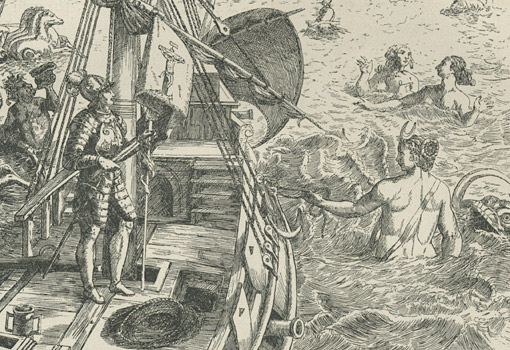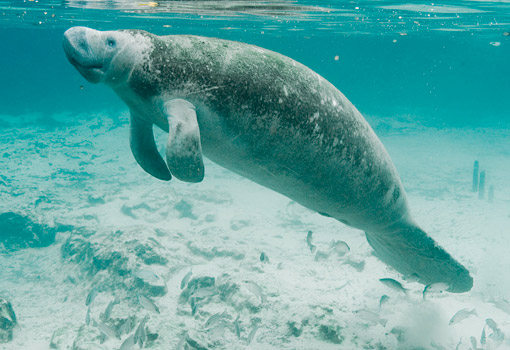
“The Vision of Columbus” after de Bry, as it appeared in Harper’s New Monthly Magazine No. 389, October 1882. (Daniel Loxton’s collection.)
Mermaids—the topic of my Junior Skeptic 48 story bound inside Skeptic Vol. 18, No. 3—are usually considered fantastical, purely imaginary creatures. (Or, at least, they were until Animal Planet and the Discovery Channel aired their infamous 2012 and 2013 documentary-style hoaxes Mermaids: The Body Found and Mermaids: The New Evidence. These hoaxes are discussed in detail in the same issue of Junior Skeptic, in a section excerpted here at INSIGHT.)
In a culture that accepts all manner of supernatural wonders, potions, and wizardry, mermaids have enjoyed a special place in the rhetoric of both organized and folk skepticism. Along with unicorns and leprechauns, mermaids have frequently served as a go-to example of a self-evidently silly claim. When science reporter John Noble Wilford1 accompanied a monster-hunting group to Loch Ness in 1976 for a series of New York Times articles, for example, skeptic Philip J. Klass2 used mermaids to poke fun at the whole enterprise. Klass wrote to the paper in his (pretend) role as “Director Pro-Tem” of the (non-existent) “Mermaid Investigation Sightings Society”:
Deepest sympathies to science news director John Noble Wilford in his hardship post along the banks of Loch Ness, covering the efforts of the Academy of Applied Science/New York Times Loch Ness Expedition. Reports of Mermaid sightings predate Nessie sightings by many centuries and have come from a wide spectrum of God-fearing, sea-faring men.
The Mermaid Investigation Sightings Society (MISS) invites the New York Times to join forces for another expedition to investigate mermaids this winter from the islands of the Caribbean. If Wilford can stand another hardship post, his press coverage would be welcome.3
Klass may have been joking, but he was of course correct that mermaid and merman sightings go back a very long way—to classical antiquity, certainly. The 1st century Roman natural historian Pliny the Elder, for example, related well-attested accounts of both Tritons (fish-tailed mermen) and Nereids (mermaids or sea nymphs).
A deputation of persons from Olisipo [Lisbon], that had been sent for the purpose, brought word to the Emperor Tiberius that a triton had been both seen and heard in a certain cavern, blowing a conch-shell, and of the form under which they are usually represented. Nor yet is the figure generally attributed to the nereids at all a fiction; only in them, the portion of the body that resembles the human figure is still rough all over with scales.4
Some towns of the ancient world even exhibited mermaids—presumably taxidermic fakes, but nonetheless part of a long-standing tradition in which mer-people were held to be creatures that physically existed in the oceans. In the centuries since, people have gone on spotting mermaids. They are, indeed, still spotted to this day.5
Cryptozoological authorities have been somewhat divided on what these sightings represent. This is not surprising. On the one hand, people say they see mermaids, and taking eyewitnesses at their word is the whole point of cryptozoology.
On the other hand…mermaids? C’mon. Surely cryptozoology is fringe enough as it is.
Erich Pontoppidan (Bishop of Bergen in Norway) made both the sea serpent and the kraken a part of global popular culture with his 1755 Natural History of Norway (a process explored in detail in Abominable Science!, my book with Donald Prothero).6 It is often forgotten that Pontoppidan gave no less weight to sightings of mermaids, and for the same reason: as with the sea serpent, lots of people said they saw mermaids.
He wasn’t altogether naive about the preposterousness of what he was proposing in his case for the mermaid. Pontoppidan was a member of the Royal Danish Academy of Sciences, an advocate for science literacy, and (surprisingly enough for a pioneering sea monster advocate) something of a skeptical investigator.7 “The existence of this creature is questioned by many, nor is it at all to be wondered at,” he acknowledged, “because most of the accounts we have had of it, are mixed with meer [sic] fables, and may be looked upon as idle tales.”8 He dismissed the more outlandish or magical tales as folkloric gloss applied to a real animal: “When such fictions are mixed with the history of the Mer-man, and when that creature is represented as a prophet and an orator; when they give the Mer-maid a melodious voice, and tell us that she is a fine singer, one need not wonder that so few people of sense will give credit to such absurdities, or that they even doubt the existence of such a creature.”9 Such embellished-seeming tales were not usually first-person accounts, Pontoppidan found; however, much more plausibly straightforward eyewitness accounts were common:
Here, in the diocese of Bergen, as well as in the manor of Nordland, are several hundreds of persons of credit and reputation, who affirm, with the strongest assurances, that they have seen this kind of creature sometimes at a distance, and at other times quite close to their boats, standing upright, and formed like a human creature down to the middle; the rest they could not see. I have spoken with many of these people, all eye-witnesses to the existence of the creature and I have taken all possible precautions in examining them strictly on the subject. The result was, that I found them all agree in every particular of their accounts….10
And indeed, Pontoppidan was surely correct that some mermaid accounts were more-or-less accurate descriptions of real animals. While it remains a matter of speculation whether dugongs or manatees (or perhaps their fossilized bones) could have contributed to the original ancient origin of the mermaid legend, they certainly seem to have played a role in more recent centuries. For example, Christopher Columbus is widely thought to have identified manatees as mermaids in 1493 on the coast of what is now the Dominican Republic:
The Admiral relates, that when on his visit to the Rio del Oro [now the Yaque Del Norte River] yesterday, he saw three mermaids standing high out of the water, they had faces something similar to those of human beings, but were not so handsome as it was customary to represent them: he adds that he has formerly seen them in Guinea, upon the Pepper coast.
Today, West Africa’s “Pepper Coast” corresponds with the Republic of Liberia—part of the range of the West African manatee. Pontoppidan quoted sources whose descriptions of mermaids are clearly identifiable as West African manatees and other sirenian mammals (a taxonomic nod to mermaids since 1811) found around the world:
“That in the Sea of Angola Mermaids are frequently catch’d, which resemble the human species. They are taken in nets, and kill’d by the negroes, and are heard to shriek and cry like women. The inhabitants on that coast eat their flesh, being very fond of it, which they say is much like pork in taste….” I shall add to all this, a passage relating to this subject, which may be met with under the article Meer-mann…in the Universal Dictionary of Arts and Sciences, published by John Theodore Jablonsky : “Meer-man, Meer-weib, Meer-minne, that is, Sea-man, Mermaid, or Siren…is a Fish found in the seas, and in some rivers in the Southern parts of Africa and India, and in the Philipine and Molucca Islands, Brasil, North America, and Europe, in the North Sea. … It has an high forehead, little eyes, a flat nose, and large mouth, but has no chin or ears. It has two arms, which are short, but without joints or elbows, with hands or paws, to each of which there are four long fingers, (which are not very flexible) connected to each other by a membrane, like that of the foot of a goose. … The females have breasts to suckle their offspring; so that the upper part of their body resembles that of the human species, and the lower part that of a Fish. Their skin is of a brownish grey colour…. Their flesh is as fat as pork, particularly the upper parts of their bodies; and this is a favourite dish with the Indians…. It makes a lamentable cry when drawn out of the water….”11
Sadly for them, the tropical dugongs and manatees are reportedly delicious, and terribly easy to catch—as was the giant sirenian of the frigid Bering Sea, Stellar’s sea cow. Extant during Pontoppidan’s time, Stellar’s sea cow was hunted to extinction within three decades of its discovery by European sailors. Disturbingly, the distress calls of manatees do sound much like screams. (Listen to audio.)

Endangered manatee in Florida, USA. (Photo by Keith Ramos. Courtesy of U.S. Fish and Wildlife Service)
References
- A two-time Pulitzer-winner in the years since; see “John Noble Wilford.” New York Times. http://topics.nytimes.com/top/reference/timestopics/people/w/john_noble_wilford/index.html (Accessed June 2, 2015)
- Klass was a science and aviation journalist and Fellow of the Committee for the Scientific Investigation of Claims of the Paranormal. During his life, he was the leading skeptic of claims relating to UFOs. His books include UFOs—Identified (1968) UFO Abductions: A Dangerous Game (1989).
- Letter published in the New York Times August 1, 1976. p. 170. For further discussion, see Philip J. Klass. “The Mermaid Investigation Sightings Society (MISS).” The Humanist. July/ August 1977. pp. 44–45. My thanks to Timothy Binga at the Center for Inquiry Libraries for helping me to secure this source.
- The Natural History (Book 9, Chapter 4). Pliny the Elder. John Bostock, trans. (London: Taylor and Francis, 1855). A thank you here to classical folklorist Adrienne Mayor for helpfully checking a key word rendered differently by different translators.
- Simon McGregor-Wood. “Photograph Israeli Mermaid, Win $1 Million.” ABC News, August 12, 2009. http://abcnews.go.com/Travel/story?id=8310324 (Accessed June 9, 2015)
- Daniel Loxton and Donald Prothero. Abominable Science: Origins of the Yeti, Nessie, and Other Famous Cryptids. (New York: Columbia University Press, 2013.) pp. 207-212
- Daniel Loxton. “Bishop Pontoppidan Versus the Tree Geese.” Skepticblog, February 8, 2011. http://www.skepticblog.org/2011/02/08/bishop-pontoppidan-versus-the-tree-geese/
- Erich Pontoppidan. Natural History of Norway: Part II. (London: A. Linde, 1755.) p. 186
- Ibid. p. 187
- Ibid. p. 190
- Ibid. pp. 188–189











Just reading last night in Oliver Sacks’ 2012 book Hallucinations discussed hallucinations due to sensory deprivation, sleep deprivation or visual field monotony, all of which would be found on an oceanic vessel spending months at see, may have played a part in the mermaid myth. Mentioned Shermer’s hallucination during his race across America as well. Fascinating.
I am a firm skeptic- I don’t believe anything that cant be proved
I hope you haven’t forgotten that in the mid-1980s some ‘very serious’ cryptologists, including Dr. Roy Wagner and Richard Greenwell, went off to New Guinea in an earnest search for the Ri: “natives of New Ireland had described the Ri as an animal with a fishlike lower body and a humanlike head and upper body–in other words, a mermaid.
“Wagner and Greenwell say they were able to maneuver their dinghy to within 50 feet of the Ri, but at that point the creature dived and never reappeared. Wagner got photographs; murky, poorly focused ones that show the tail of an unidentifiable marine animal raised out of the water.”
I wrote about the folly of all this in my Psychic Vibrations column (Skeptical Inquirer, Summer 1982; Winter, 1983-4; p. 195-199 of the book Psychic Vibrations). I caught a lot of heat for making fun of this, and Greenwell (a former UFOlogist with APRO, who I knew) called me several times to berate me for my excessive skepticism. “We’re not looking for mermaids, we’re looking for Ri.” And what is a Ri? “an animal with a fishlike lower body and a humanlike head and upper body”
http://articles.chicagotribune.com/1985-01-27/news/8501060077_1_richard-greenwell-cryptozoology-marine-mammal
I have not forgotten! It’s one of my favorite stories in the annals of cryptozoology. I’ll be discussing it here in a future post.